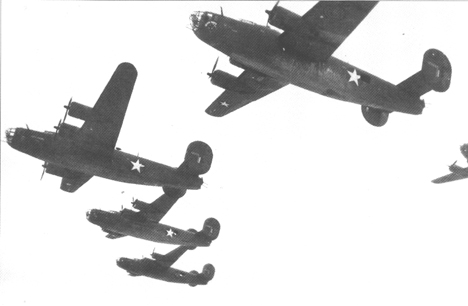

The Combined Bomber Offensive (Operation Pointblank) evolved beginning with
the entrance of the United States into World War II. The Army Air Forces
(AAF) were committed to "destruction of selected vital elements of the
German military and industrial machine through precision bombing in
daylight." The Royal Air Force was to concentrate upon "mass air attacks of
industrial areas at night, to break down morale" and thus limit German
production.
When this division of work was firmly established at the Casablanca
Conference in January 1943, the AAF did not have sufficient crews or
aircraft for sustained strategic operations. By the summer of 1943 priority
targets were worked out and some ambitious AAF raids scheduled. Priorities
for the offensive were aircraft manufacturing plants, anti-friction bearings
factories (on the theory that stopping key industries would have large
effects on the Germany war effort), petroleum refineries, and other targets.
The most inviting oil target was at Ploesti which was thought to
produce a third of Germany's liquid fuel requirements. The Rumanian
targets were at the limit of the range of American aircraft and could not be
reached from England. The oil fields and refineries had been ineffectually
attacked by the Russian Air Force and, in January 1942, by American bombers
from the Middle East.
Planning for a major mission began in earnest when the Germans in Tunisian
were close to defeat. Five groups of B-24 Liberators were assigned to the
task, three of them borrowed from the Eighth Air Force in the United
Kingdom. Under command of the Ninth Air Force, the groups practiced
low-level formation flying and bombing at bases near Bengazi, Libya.
After dawn on 1 August 1943, 177 B-24s under the command of Brigadier
General Uzal G. Ent, who flew with the lead group, the 376th Bombardment
Group, the most experienced heavy bomber unit in the Mediterranean area
approached Ploesti. The route was past Corfu Island and northeast over the
mountains of Albania and Yugoslavia.
The formations, somewhat disorganized by the loss of the lead navigator,
descended to 500 feet at Pitesti, 65 miles from the targets. Halfway to the
initial point where the final turn was to be made into Ploesti, the 376th
Group, followed by the 93rd Bombardment Group, made an erroneous turn
southeast toward Bucharest. The other bomb groups, the 389th, 98th, and
44th, continued as briefed. When Ent discovered the error, both groups
headed back toward Ploesti. The 376th was told to strike targets of
opportunity, and the 93rd attacked the original targets from the opposite
direction as briefed.
The return flight to Libya was disorganized and under heavy German fighter
attack for much of the way. In all, 54 planes were lost, but the bombing
destroyed up to 42 percent of Ploesti's cracking capacity. The AAF's 30
percent losses meant that a follow-up mission was not practical, and with no
opposition, the Germans were able to repair the facilities rapidly.
Five
officers received the Medal of Honor for bravery on this mission.